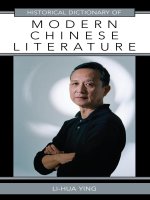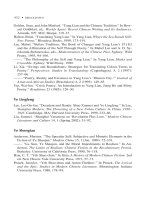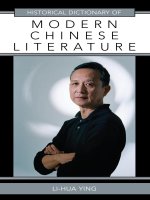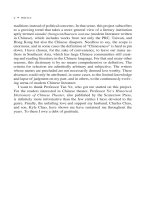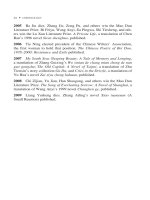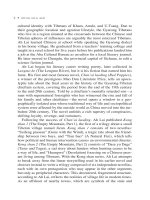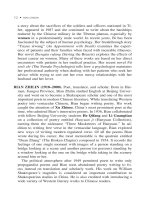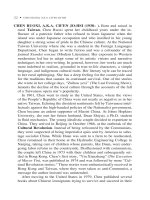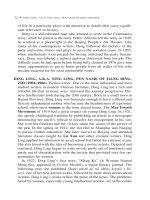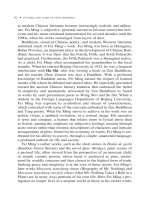historical dictionary of modern chinese literature
Bạn đang xem bản rút gọn của tài liệu. Xem và tải ngay bản đầy đủ của tài liệu tại đây (1.14 MB, 495 trang )
For orders and information please contact the publisher
SCARECROW PRESS, INC.
A wholly owned subsidiary of
The Rowman & Littlefield Publishing Group, Inc.
4501 Forbes Boulevard, Suite 200
Lanham, Maryland 20706
1-800-462-6420 • fax 717-794-3803
www.scarecrowpress.com
COVER IMAGE: GAO XINGJIAN
© SOPHIE ELBAZ / SYGMA / CORBIS
LITERATURE • CHINESE LITERATURE
MODERN
CHINESE
LITERATURE
LI-HUA YING
HISTORICAL
DICTIONARY
OF
Historical Dictionaries of Literature and the Arts, No. 35
Modern Chinese literature has been flourishing for more than a century, with
varying degrees of intensity and energy at different junctures of history and
points of locale. Although it has been challenged and enriched by external
influences, it is an integral part of world literature in constant dialogue with its
counterparts across the globe—contributing to the wealth of worldwide literary
culture. In terms of themes and styles, modern Chinese literature is rich and var-
ied: from revolutionary to pastoral, romanticism to feminism, and modernism
to postmodernism, as well as critical, psychological, socialist, and magical real-
ism. Indeed, it encompasses a full range of ideological and aesthetic concerns.
This Historical Dictionary of Modern Chinese Literature presents a broad
perspective of the development and history of literature in modern China. It
includes a chronology, introduction, bibliography, and more than 300 cross-
referenced dictionary entries on authors, literary and historical developments,
trends, genres, and concepts playing a central role in the evolution of modern
Chinese literature.
Li-hua Ying is director of the Chinese and Japanese Program at Bard College,
Annandale-on-Hudson, New York. She is also the executive director of the
Association of Shufa Calligraphy Education, an academic organization based
in the United States.
YING
HISTORICAL DICTIONARY OF
MODERN
CHINESE
LITERATURE
HD Modern Chinese Lit Litho.indd1 1HD Modern Chinese Lit Litho.indd1 1 10/28/09 1:59:21 PM10/28/09 1:59:21 PM
Historical Dictionaries of Literature and the Arts
Jon Woronoff, Series Editor
1. Science Fiction Literature, by Brian Stableford, 2004.
2. Hong Kong Cinema, by Lisa Odham Stokes, 2007.
3. American Radio Soap Operas, by Jim Cox, 2005.
4. Japanese Traditional Theatre, by Samuel L. Leiter, 2006.
5. Fantasy Literature, by Brian Stableford, 2005.
6. Australian and New Zealand Cinema, by Albert Moran and
Errol Vieth, 2006.
7. African-American Television, by Kathleen Fearn-Banks, 2006.
8. Lesbian Literature, by Meredith Miller, 2006.
9. Scandinavian Literature and Theater, by Jan Sjåvik, 2006.
10. British Radio, by Seán Street, 2006.
11. German Theater, by William Grange, 2006.
12. African American Cinema, by S. Torriano Berry and Venise
Berry, 2006.
13. Sacred Music, by Joseph P. Swain, 2006.
14. Russian Theater, by Laurence Senelick, 2007.
15. French Cinema, by Dayna Oscherwitz and MaryEllen Higgins,
2007.
16. Postmodernist Literature and Theater, by Fran Mason, 2007.
17. Irish Cinema, by Roderick Flynn and Pat Brereton, 2007.
18. Australian Radio and Television, by Albert Moran and Chris
Keating, 2007.
19. Polish Cinema, by Marek Haltof, 2007.
20. Old Time Radio, by Robert C. Reinehr and Jon D. Swartz, 2008.
21. Renaissance Art, by Lilian H. Zirpolo, 2008.
22. Broadway Musical, by William A. Everett and Paul R. Laird,
2008.
23. American Theater: Modernism, by James Fisher and Felicia
Hardison Londré, 2008.
24. German Cinema, by Robert C. Reimer and Carol J. Reimer,
2008.
25. Horror Cinema, by Peter Hutchings, 2008.
26. Westerns in Cinema, by Paul Varner, 2008.
27. Chinese Theater, by Tan Ye, 2008.
28. Italian Cinema, by Gino Moliterno, 2008.
29. Architecture, by Allison Lee Palmer, 2008.
30. Russian and Soviet Cinema, by Peter Rollberg, 2008.
31. African American Theater, by Anthony D. Hill, 2009.
32. Postwar German Literature, by William Grange, 2009.
33. Modern Japanese Literature and Theater, by J. Scott Miller,
2009.
34. Animation and Cartoons, by Nichola Dobson, 2009.
35. Modern Chinese Literature, by Li-hua Ying, 2010.
Historical Dictionary
of Modern Chinese
Literature
Li-hua Ying
Historical Dictionaries of Literature and the Arts,
No. 35
THE SCARECROW PRESS, INC.
Lanham • Toronto • Plymouth, UK
2010
Published by Scarecrow Press, Inc.
A wholly owned subsidiary of The Rowman & Littlefield Publishing Group, Inc.
4501 Forbes Boulevard, Suite 200, Lanham, Maryland 20706
Estover Road, Plymouth PL6 7PY, United Kingdom
Copyright © 2010 by Li-hua Ying
All rights reserved. No part of this book may be reproduced in any form or by any
electronic or mechanical means, including information storage and retrieval systems,
without written permission from the publisher, except by a reviewer who may quote
passages in a review.
British Library Cataloguing in Publication Information Available
Library of Congress Cataloging-in-Publication Data
Ying, Li-hua.
Historical dictionary of modern Chinese literature / Li-hua Ying.
p. cm. — (Historical dictionaries of literature and the arts ; no. 35)
Includes bibliographical references.
ISBN 978-0-8108-5516-8 (cloth : alk. paper) — ISBN 978-0-8108-7081-9 (ebook)
1. Chinese literature—20th century—Dictionaries—English. 2. Chinese
literature—20th century—Bio-bibliography. 3. Authors, Chinese—20th century—
Biography—Dictionaries. I. Title.
PL2303.Y59 2010
895.1'09'00503—dc22 2009027237
ϱ
™
The paper used in this publication meets the minimum requirements of
American National Standard for Information Sciences—Permanence of Paper
for Printed Library Materials, ANSI/NISO Z39.48-1992.
Printed in the United States of America
v
Editor’s Foreword Jon Woronoff vii
Preface ix
Reader’s Notes xi
Chronology xiii
Introduction xxi
THE DICTIONARY 1
Bibliography 295
About the Author 465
Contents
vii
Chinese literature is an amazingly hardy breed. During the modern period,
roughly since the beginning of the 20th century, it has had to contend with
the most adverse conditions: Confucianism, Buddhism, and imperial rule;
invasion and occupation by Japan; the long civil war between the Nation-
alists and the Communists, and then under communism the dictates of
Mao Zedong and other leaders; and the rampant materialism of the present
day. Yet, in every period, it has found forms of expression and in some
cases flourished, leaving an impressive legacy that is still being enriched
at present. Alas, while those who know Chinese can enjoy it, this privilege
is only gradually being shared with outsiders as more and more works are
translated into English and other languages. This is finally encouraging
its spread to new readers and new admirers, who are becoming familiar
with a plethora of new authors—novelists, essayists, playwrights, and
poets—and masses of intriguing works. Yet, this did not emerge from a
vacuum, and Chinese literature is much easier to fathom in the context of
its historical and literary trends.
Providing this context, and introducing the authors and their works, is
the main task of this Historical Dictionary of Modern Chinese Literature.
It goes about it in several ways. The chronology traces the evolution, one
with many twists and turns and only rare straight stretches, which partially
account for the variety and diversity. The introduction provides a useful
overview, one in which to insert the authors and their works. The diction-
ary follows on with hundreds of entries on writers, in all possible genres,
of all possible proclivities, with varying styles and subject matter. Other
entries present the historical and political events that impacted on this
literature and the assorted literary currents and trends that shaped it. Since
China is a vast country, with a population of over a billion, it is helpful
to remember that it consists of regions, some of which have their own
traditions, such as Tibet, and also that Chinese writers not only live and
create in the People’s Republic of China but also the Republic of China
Editor’s Foreword
(Taiwan), Hong Kong, and Southeast Asia and, indeed, at present in the
United States and other Western countries. Having once discovered how
rich this literature is, there will inevitably be many who will want to read
the works either in the original or translation and gain further background,
which is facilitated by the bibliography.
Given the extensive period, the geographical spread, and the broad
range of writers and works, the author of this volume has done an ex-
traordinary job of bringing all the various strands together and providing
a comprehensive picture. Li-hua Ying grew up in the People’s Republic
of China and studied at Yunnan Normal University, where she received a
B.A. in English and also briefly taught. Moving to the United States, and
not without maintaining her interest in English literature, she has increas-
ingly specialized in Chinese literature. With a foot in each culture, and at-
tuned to the increasing flows between them, she is an excellent guide to the
literature of the world’s largest cultural community, the rapidly expanding
literary output of which is bound to be known and read increasingly in
coming years.
Jon Woronoff
Series Editor
viii • EDITOR’S FOREWORD
ix
How to define “modern Chinese literature”? The challenge has to do spe-
cifically with the terms modern and Chinese. First of all, when does the
modern period begin and end? Second, by “Chinese,” does one mean “of
China” or “in the Chinese language”? If the scope is limited to 1918 to
1949, then the issue can be settled without much controversy. If the histori-
cal line stretches further down, however, the problem becomes potentially
divisive. What about Taiwan? What about prehandover Hong Kong? And
the Chinese diaspora?
In the process of sorting through nearly a century of literary production,
I have decided to adopt a more inclusive, thus more controversial, defini-
tion of “modern Chinese literature” in order to take into consideration
the complex and diverse paths of its development. In terms of historical
framework, I begin with the May Fourth generation and continue to the
present. Acknowledging the defining role of the vernacular language, I
have chosen to exclude texts written in classical Chinese during the same
period. In terms of geographical boundary, I have also opted for a more in-
clusive line of demarcation. In addition to writers in the People’s Republic
of China, Taiwan, and Hong Kong, those who have settled in the West but
continue to address the topic of, for the lack of a better word, “Chinese-
ness,” are considered as part of the modern Chinese literary enterprise.
Treating modern Chinese literature as a continuous and borderless entity,
this dictionary of Modern Chinese Literature thus adopts a liberal usage
of the words Chinese and modern by selecting from writers publishing
since the beginning of the 20th century to the present whose language of
expression is Chinese. A more accurate but cumbersome title could be “A
Dictionary of Modern Chinese (Language) Literature.”
I am certainly aware that the inclusion of Taiwanese writers in this dic-
tionary could be a point of contention. My process of selection, however,
is guided by considerations of linguistic as well as cultural and literary
Preface
traditions instead of political concerns. In that sense, this project subscribes
to a growing trend that takes a more general view of a literary institution
aptly termed xiandai zhongwen/huawen wenxue (modern literature written
in Chinese), which includes works from not only the PRC, Taiwan, and
Hong Kong but also the Chinese diaspora. Needless to say, the scope is
enormous, and in some cases the definition of “Chineseness” is hard to pin
down. I have chosen, for the sake of convenience, to leave out many au-
thors in Southeast Asia, which has large Chinese communities still creat-
ing and reading literature in the Chinese language. For that and many other
reasons, this dictionary is by no means comprehensive or definitive. The
criteria for selection are admittedly arbitrary and subjective. The writers
whose names are precluded are not necessarily deemed less worthy. These
absences could only be attributed, in some cases, to the limited knowledge
and lapse of judgment on my part, and in others, to the continuously evolv-
ing arena of modern Chinese literature.
I want to thank Professor Tan Ye, who got me started on this project.
For the readers interested in Chinese theater, Professor Ye’s Historical
Dictionary of Chinese Theater, also published by the Scarecrow Press,
is infinitely more informative than the few entries I have devoted to the
genre. Finally, the unfailing love and support my husband, Charles Chao,
and son, Kyle Chao, have shown me have sustained me throughout the
years. To them I owe a debt of gratitude.
x • PREFACE
xi
The Pinyin system is used to transliterate Chinese terms, except for
names that are commonly Romanized, therefore, Taipei instead of Taibei,
Chiang Kai-shek instead of Chiang Jieshi, Hong Kong not Xianggang.
With regard to writers whose names have more than one transliteration,
the Pinyin transliteration is the primary form used with the additional
transliteration(s) provided in the dictionary as “a.k.a.” (also known as) and
in the bibliography in the parenthesis immediately following the Pinyin
name. For the sake of consistency, Beijing is used instead of Beiping, the
official name adopted during the Republican period (1911–1949).
In the Chinese convention, the surname goes before the given name.
When the author’s name is mentioned for the first time, the full name is
used; subsequently, only the surname is given. In the case of pen names,
the conventional use of the full name is adopted. Hence, Lu Xun, instead
of Lu, is used throughout the entry.
When a title is mentioned for the first time, the Pinyin title goes before
the English translation. Subsequent mentions of the same title are in Pin-
yin alone. Pinyin titles are not capitalized, except for the first letter of the
first word and proper names. English translations of Chinese titles are,
however, capitalized. Whenever possible, published English titles, shown
in italics within parentheses, are used; in the case when no English pub-
lication is available, an English translation, not italicized, is provided by
the author. When a term has an entry of its own in the dictionary, the term
appears in boldface the first time it is mentioned in an entry other than
its own. There are a few acronyms and abbreviations used throughout the
dictionary; they are listed below with their full names:
CCP: Chinese Communist Party
DPP: Democratic Progressive Party
KMT: Kuomintang (Nationalist Party)
PRC: People’s Republic of China
ROC: Republic of China
Reader’s Notes
xiii
1891 Su Manshu publishes his translation of Lord Byron’s poems,
Bailun shi xuan (Poems by Byron), the first collection of Western poetry
in Chinese.
1898 “Lun baihua wei weixin zhi ben” (The Vernacular Language as the
Basis for Reforms) by Qiu Tingliang published.
1902 Liang Qichao creates in Japan the first modern Chinese fiction
journal Xin xiaoshuo (New Fiction).
1906 Chunliu she (Spring Willow Society) established to perform spo-
ken drama.
1911 Qing dynasty toppled. Republic of China founded.
1914 Libailiu (Saturday) created to publish mainly works by authors of
the Mandarin Ducks and Butterflies school. Wan’ou zhi jia, Chinese trans-
lation of Henrik Ibsen’s A Doll’s House, premieres in Shanghai.
1915 Xin qingnian (New Youth) founded to promote xin wenxue (new
literature) and progressive ideas; its first issue is edited by Chen Duxiu, a
cofounder of the Chinese Communist Party.
1916 Chinese National Language Research Association founded.
1917 Xin qingnian publishes Hu Shi’s article “Wenxue gailiang chu
yi” (Preliminary Opinion on Literary Reform) and Chen Duxiu’s article
“Wenxue geming lun” (On Literary Revolution), formally sounding the
call for a new, revolutionary literature. Poems written in bai hua (vernacu-
lar Chinese) by Hu Shi also published.
1918 The first Romanized phonetic system introduced. Xin qingnian
publishes Lu Xun’s short story “Kuangren riji” (Diary of a Mad Man),
vernacular poems by Hu Shi, Liu Bannong, and others, translations of
Chronology
Ibsen’s plays, and Zhou Zuoren’s article “Ren de wenxue” (A Literature
for Humanity).
1919 May Fourth Movement erupts.
1920 Hu Shi’s poetry collection Changshi ji (Experiments) and Guo
Moruo’s poem “Fenghuang niepan” (The Phoenix Rising from the Ashes)
published.
1921 Wenxue yanjiu hui (Literary Society), Chuangzao she (Creation
Society), Minzhong xiju she (Society of People’s Theater), Shanghai Xiju
xie she (Shanghai Theater Association), and the Chinese Communist Party
founded. The first issue of Xiju (Theater Weekly) published. Yu Dafu’s
Chenlun (Sinking), the first collection of short stories in modern Chinese
literature, and Guo Moruo’s poems Shen nü published.
1922 Hupan shi she (Lakeside Poetry Society) founded.
1923 Xin yue shi she (Crescent Society) and Xin yue (Crescent Monthly)
founded. Lu Xun’s short story collection Nahan (Call to Arms) and Wen
Yiduo’s poetry collection Hong zhu (Red Candle) published.
1924 Yu si she (Language Society) and Yu si (Language Weekly)
founded. Zhu Ziqing’s collection of essays and poems Zongji (Traces) and
Tian Han’s collection of plays Kafei dian zhi yi ye (One Night at a Café)
published.
1925 Cheng Fangwu’s article “Cong wenxue geming dao geming
wenxue” (From Literary Revolution to Revolutionary Literature) pub-
lished, triggering the debate between Lu Xun and the Creation Society on
the nature and direction of literature. Zhimo de shi (Collection of Poems
by Zhimo) published.
1926 Chuangzao yuekan (Creation Monthly) founded; Lu Xun’s short
story collection Panghuang (Wandering), Lao She’s novel Lao Zhang de
zhexue (Mr. Zhang’s Philosophy), and Bing Xin’s collection of essays Ji
xiao duzhe (To Young Readers) published.
1927 Xu Zhimo’s poetry collection Feilengcui de yi ye (One Night in
Florence) published.
1928 Xiandai xiaoshuo (Modern Fiction Monthly) created. Ding Ling’s
short story “Shafei nüshi de riji” (Miss Sophie’s Diary), Ye Shengtao’s
novel Ni Huanzhi (Ni Huanzhi the Schoolteacher), Wen Yiduo’s poetry
xiv • CHRONOLOGY
collection Si shui (Dead Water), and Fei Ming’s collection of stories Tao
yuan (Peach Orchard) published.
1929 Mao Dun’s novel Hong (Rainbow) and Tian Han’s play Ming you
zhi si (The Death of a Famous Actress) published.
1930 Zhongguo zuoyi zuojia lianmeng (Left-wing Association of Chi-
nese Writers), Zhongguo zuoyi xijujia lianmeng (Left-wing Association
of Chinese Dramatists), and Shidai xiju she (Modern Drama Society)
founded. Literary journal Mengya (Sprouts) created.
1931 Japan invades China’s northeast. Xu Zhimo dies in a plane crash.
1932 Fei Ming’s Moxuyou Xiansheng zhuan (Biography of Mr. Nothing)
published.
1933 Mao Dun’s novel Ziye (Midnight), Ba Jin’s novel Jia (Family),
Shi Zhecun’s short story collection Meiyu zhi xi (One Rainy Evening) and
Wangshu cao (Writings of Wangshu) published. George Bernard Shaw
visits China.
1934 Taiwan Wenyi Lianmeng (The Literary and Art Alliance of Tai-
wan) founded. Cao Yu’s play Leiyu (Thunderstorm) and Shen Congwen’s
Biancheng (Border Town) published.
1935 Xiao Hong’s novella “Shengsi chang” (Life and Death), Xiao Jun’s
novel Bayue de xiangcun (Village in August) published.
1936 Lu Xun dies. Left-Wing Association of Chinese Writers disbanded.
Lao She’s Luotuo xiangzi (The Rickshaw Boy), Ai Qing’s poetry Day-
anhe—Wode baomu (Dayan River—My Wet-nurse), and Shi Zhecun’s
short story collection Meiyu zhi xi (One Rainy Evening) published.
1937 Sino-Japanese War breaks out. Li Jieren’s novel Si shui wei lan
(Ripples across a Stagnant Water) published.
1941 Japan occupies Shanghai.
1942 Mao Zedong delivers his speeches at the Yan’an Forum on Litera-
ture and Art. Feng Zhi’s Shisi hang ji (The Sonnets) published.
1943 Zhang Ailing’s stories “Qing cheng zhi lian” (Love in a Fallen
City) and “Jin suo” (The Golden Cangue), and Zhao Shuli’s novella “Li
Youcai banhua” (Li Youcai’s Rhymed Ballads) published.
CHRONOLOGY • xv
1945 Japan surrenders. Civil war breaks out between the Communists
and the Nationalists.
1946 Wen Yiduo assassinated.
1947 Chinese Writers’ Association founded in Beijing. February 28
Incident takes place in Taiwan, pitting the Nationalist government against
the Taiwanese protestors. Qian Zhongshu’s Wei cheng (Fortress Besieged)
published.
1949 The Nationalist government withdraws to Taiwan. The People’s
Republic of China (PRC) established. Liang Shiqiu’s collection of essays
Yashe xiaopin (Sketches from a Refined Cottage) published.
1951 Ding Ling’s novel Taiyang zhao zai Sanggan He shang (The Sun
Shines Over the Sanggan River) and Sun Li’s novel Fengyun jishi (Stormy
Years) published.
1952 Ding Ling’s novel Taiyang zhao zai Sanggan He shang and Zhou
Libo’s novel Baofeng zhouyu (The Storm) win the Stalin Literature Prize.
1953 Xiandai shi (Modern Poetry) founded in Taiwan.
1954 Yuan Guangzhong’s Lanse de yumao (Blue Feathers) published.
1956 Shu Xiangcheng’s novel Wu Xianggang (Misty Hong Kong) pub-
lished.
1957 Anti-Rightist Campaign launched.
1958 Great Leap Forward launched. Lao She’s play Cha guan (Teahouse)
published.
1960 Xiandai wenxue (Modern Literature) founded at National Taiwan
University. Lin Haiyin’s memoir Cheng nan jiu shi (Memories of Peking:
Southside Stories) published.
1965 Hao Ran’s novel Yanyang tian (Bright Clouds) published.
1966 Cultural Revolution launched. Lao She commits suicide.
1969 Huang Chunming’s Erzi de da wan’ou (His Son’s Big Doll)
published.
1971 Bai Xianyong’s short story collection Taipei ren (Taipei
Characters) published.
xvi • CHRONOLOGY
1975 Chiang Kai-shek dies.
1976 Mao Zedong dies. Chen Ruoxi’s Yin xianzhang (The Execution of
Mayor Yin) published.
1977 Xiangtu wenxue lunzhan (Debates on Nativist Literature) is held
between the nativists and the modernists. Cultural Revolution officially
ends. College entrance exams resumed in the PRC.
1978 Lu Xinhua’s short story “Shangheng” (Scars) published, launching
the trend of “scar literature.” Poetry journal Jintian (Today), the main plat-
form for Menglong shi (Misty poetry), founded. Deng Xiaoping consoli-
dates his power in the Chinese Communist Party and the Deng era begins
with economic reforms under way. Yang Mu shi ji (Poems by Yang Mu)
published in Taiwan and Lei sheng yu chan ming (Thunder and Songs of
Cicadas: Poems by Liang Bingjun) published in Hong Kong.
1979 Democracy Wall Movement erupts. Wang Wenxing’s novel Jia
bian (Family Catastrophe) published. Liu Xingwu’s Banzhuren (The Class
Counsellor) and Gao Xiaosheng’s Li Shunda zaowu (Li Shunda Builds a
House) published.
1980 Shanghai Literature and Art Press publishes Waiguo xiandai pai
zuopin xuan (Selected Works of Western Modernism) edited by Yuan Ke-
jia. Yao Xueyin, Gu Hua, and others win the Mao Dun Literature Prize.
1981 Mao Dun dies. Mao Dun Literature Prize established to give
awards every four years to novelists. Gao Xingjian’s Xiandai xiaoshuo
jiqiao chutan (A Preliminary Study of Modern Fiction Techniques) pub-
lished. Wang Wenxing’s modernist novel Bei hai de ren (Backed against
the Sea) published.
1982 Wang Zengqi duanpian xiaoshuo xuan (Selected Short Stories by
Wang Zengqi) published.
1983 Antispiritual Pollution Campaign launched in the PRC. Bai Xian-
yong’s novel Niezi (Crystal Boys), the first novel on the subject of homo-
sexuality by a modern Chinese writer, published. Li Ang’s feminist novel
Sha fu: Lucheng gushi (The Butcher’s Wife) published. Gao Xingjian’s
play Che zhan (Bus Stop) premiers in Beijing.
1984
Conference on “cultural root-seeking” held in Hangzhou. Ah
Cheng’s novella “Qi wang” (The King of Chess), a representative work in
CHRONOLOGY • xvii
the root-seeking movement, and Wang Meng’s Dan huise de yanzhu—zai
Yili (Light Grey Eyes—in Yili) published. Wang Zhenhe’s novel Meigui
meigui wo ai ni (Rose, Rose I Love You) published.
1985 Zhang Jie, Liu Xinwu, and others win the Mao Dun Literature
Prize. Han Shaogong’s “Wenxue de gen” (The Roots of Literature) and
Deng Youmei’s Yanhu (Snuff Bottles), two important works of the root-
seeking movement, and Ma Yuan’s “Gangdisi de youhuo” (Under the
Spell of the Gangtise Mountains), an influential experimental story based
on Tibet, published.
1986 Ding Ling dies. Taiwan’s Lianhe wenxue xiaoshuo xin ren jiang
(Unitas New Fiction Writers Prize) established. Zhongguo xiandan shi
qunti da zhan (The Grand Showcase of Chinese Modern Poetry Move-
ments) is organized by Xu Jingya and Jiang Weiyang, providing a platform
to display works of Generation III poets. The official Chinese Writers’ As-
sociation creates the Lu Xun Literature Prize to award excellence in short
story, novella, reportage, poetry, prose, literary theory and criticism, and
translation. Gu Cheng’s poem collection Hei yanjin (Eyes of Darkness)
published.
1987 Taiwan’s martial law lifted. Liang Shiqiu dies in Taiwan. Ye
Weilian’s Sanshi nian shi (Poems Written in Thirty Years) published.
1988 Chiang Ching-kuo dies. Shen Congwen dies. Lu Yao, Huo Da, and
others win the Mao Dun Literature Prize. Chen Yingzhen’s Wo de didi
Kangxiong (My Younger Brother Kangxiong) and Lin Yaode’s E dixing
(The Ugly Land) published. Su Tong’s Yijiusansinian de taowang (The
Escapes in 1934) published.
1989 Tian’anmen Prodemocracy Movement erupts. Dialogues in Para-
dise, a translation of Can Xue’s short stories, published.
1990 Gao Xingjian’s novel Ling shan (Soul Mountain) published.
1991 Eryue He’s Yongzheng Huangdi (Emperor Yongzheng) published.
1992 Wang Xiaobo’s Huangjin shidai (The Gold Times) published in
Taiwan.
1993 Poet Gu Cheng commits suicide. Jia Pingwa’s controversial novel
Fei du (The Capital City in Ruins) and Chen Zhongshi’s Bai lu yuan (The
White Deer Plain) published. Red Sorghum, a translation of Mo Yan’s
xviii • CHRONOLOGY
novel Hong Gaoliang, and Backed against the Sea, a translation of Wang
Wenxing’s Bei hai de ren, published.
1994 Chen Zhongshi and others win the Mao Dun Literature Prize. Zhu
Tianwen wins the Shibao Literature One Million (New Taiwan) Dollar
Prize with Huang ren shouji (Notes of a Desolate Man).
1995 Zhang Ailing dies. Museum of Modern Chinese Literature estab-
lished in Beijing.
1996 Xi Xi’s Fei zhan (Flying Carpet: A Tale of Fertilla) published.
1997 Hong Kong handed over to China.
1998 Zhang Guixing wins the Shibao Literature One Million (New
Taiwan) Dollar Prize. Chi Zijian, Liu Heng, Xu Xiaobin, Li Guowen, Tie
Ning, and others win the Lu Xun Literature Prize.
1999 Asia Weekly (Hong Kong) names 100 Best Chinese Fictional
Works in the 20th Century, judged by specialists from mainland China,
Taiwan, Hong Kong, Malaysia, and the United States. Mengya (Sprouts), a
literary journal based in Shanghai, establishes New Concept Composition
Contest to identify and promote young writers.
2000 Gao Xingjian awarded the Nobel Prize for Literature. Wang Anyi,
Wang Xufeng, and Ah Lai win the Mao Dun Literature Prize. Zhang
Guixing’s Hou bei (The Primate Cup) published. Notes of a Desolate Man,
a translation of Zhu Tianwen’s Huang ren shouji, published.
2001 Hua zong shijie Huawen wenxue jiang (Flower Trail World Chi-
nese Language Literature Prize), established in Malaysia, names Wang
Anyi the recipient of its first prize.
2002 Yang Lian’s long poem YI [Yi] published. Red Poppies, a transla-
tion of Ah Lai’s 1998 novel Chen’ai luoding, published.
2003 Chen Yingzhen wins the Flower Trail World Chinese Language
Literature Prize. A Dictionary of Maqiao, a translation of Han Shaogong’s
1996 Maqiao cidian, and Retribution: The Jiling Chronicles, a translation
of Li Yongping’s 1986 novel Jilin chunqiu, published.
2004 Fan Wen’s novel Shui ru dadi (Land of Harmony) and Yu Jian’s
Ling dang’an: changshi qi bu yu biantiao ji (File 0: Seven Long Poems
and Notes) published.
CHRONOLOGY • xix
2005 Ba Jin dies. Zhang Jie, Zong Pu, and others win the Mao Dun
Literature Prize. Bi Feiyu, Wang Anyi, Jia Pingwa, Shi Tiesheng, and oth-
ers win the Lu Xun Literature Prize. A Private Life, a translation of Chen
Ran’s 1996 novel Siren shenghuo, published.
2006 Tie Ning elected president of the Chinese Writers’ Association,
the first woman to hold that position. The Chinese Poetry of Bei Dao,
1978–2000: Resistance and Exile published.
2007 My South Seas Sleeping Beauty: A Tale of Memory and Longing,
a translation of Zhang Guixing’s Wo sinian de chang mian zhong de nan
guo gongzhu; The Old Capital: A Novel of Taipei, a translation of Zhu
Tienxin’s story collection Gu Du; and Cries in the Drizzle, a translation of
Yu Hua’s novel Zai xiyu zhong huhuan, published.
2008 Chi Zijian, Yu Jian, Han Shaogong, and others win the Mao Dun
Literature Prize. The Song of Everlasting Sorrow: A Novel of Shanghai, a
translation of Wang Anyi’s 1999 novel Changhen ge, published.
2009 Liang Yusheng dies. Zhang Ailing’s novel Xiao tuanyuan (A
Small Reunion) published.
xx • CHRONOLOGY
xxi
Modern Chinese literature has been flourishing for over a century, with
varying degrees of intensity and energy at different junctures of history
and points of locale. It is solidly an integral part of world literature, for
from the moment it was born, it has been in dialogue with its counterparts
from the rest of the world. As it has been challenged and enriched by ex-
ternal influences, it has contributed to the wealth of literary culture of the
world. Gone are the days when a Western reader picked up a book of mod-
ern Chinese literature for nonliterary reasons and when Chinese novels
or poems were treated as sociopolitical documents. Nowadays, it is more
likely that readers appreciate a Chinese novel because it is a great piece
of art, not simply because it provides knowledge and information about
Chinese society and politics. Indeed, the best literature written in Chinese
is on a par with the best literature written in any other language; this has
been especially true during the past three decades, which have given us
some internationally recognized names, even a Nobel laureate. In terms of
themes and styles, modern Chinese literature is rich and varied: from the
revolutionary to the pastoral, from romanticism to feminism, from mod-
ernism to postmodernism, critical realism, psychological realism, socialist
realism, and magic realism, you name it. Indeed, it encompasses a full
range of ideological and aesthetic concerns.
In some ways, what gives modern Chinese literature its vibrant diver-
sity is its geographic range. Here the term Chinese literature should not
be mistaken for “literature of China”—although the People’s Republic of
China (PRC) itself is already a mind-boggling size—for its creators and
readers are widely spread all over the globe. It is not an exaggeration to
say that where there are Chinese communities, there is Chinese literature
being read and written. Beyond the borders of China, Taiwan, and Hong
Kong, there is a whole population of Chinese writers scattered throughout
Southeast Asia, Europe, and North America who are connected in their
Introduction
love of the Chinese language as the medium of artistic expression. This is
the landscape of Chinese literature today.
In the study of Chinese history, modern China is generally divided into
three periods: jindai (the recent era), 1840–1911; xiandai (the modern
era), 1911–1949; and dangdai (the present era), 1949 to the present. The
curtains of the jindai era were forced open by guns and cannons of West-
ern forces in the mid-19th century. During the next six decades, the Qing
dynasty (1644–1911) lost the Opium Wars to Great Britain, its navy was
soundly defeated by Japan, and its territories were ceded to the Europeans,
Russians, and Japanese. Although the Republican Revolution led by Sun
Yat-sen succeeded in overthrowing the feeble and corrupt Qing empire
and established the Republic of China in 1911, civil wars put the young
republic in grave danger and the country continued to be dominated by
foreign powers. Popular discontent reached a boiling point in 1919, when
the Versailles Conference transferred the German concessions in Shan-
dong to Japan, instead of returning them to Chinese sovereignty, causing
widespread protests that later developed into a full-blown cultural cru-
sade known as the May Fourth Movement. A nationwide soul-searching
ensued, led by progressive intellectuals who blamed China’s weakened
state on its fundamental cultural institutions that in their view had become
obsolete and incapable of dealing with the modern world. For the survival
of the Chinese nation, they argued, Western ideas and practices, includ-
ing literature, had to be imported. In this Westward-looking environment,
science and democracy became coded terms that represented modernity,
progress, and hope for a national salvation.
Prior to the 1980s, most literary scholars tended to adopt the same
categories established by historians and saw the May Fourth Movement,
which dominated Chinese intellectual discourse in the 20th century, as
the force behind the emergence and development of China’s literary
revolution. The term widely used to describe the literature born out the
May Fourth Movement is xin wenxue (new literature). Wang Yao in his
Zhongguo xin wenxue shi gao (A History of Chinese New Literature) em-
phasized the umbilical relationship between the new literature and the May
Fourth Movement and puts “anti-imperialism” and “anti-feudalism”
at the
forefront of not only the political and cultural but also the literary agenda.
1
Agreeing with Wang, Qian Liqun, Tang Tao, and Yan Jiayan also regarded
1949, when the PRC was established as a watershed, but they preferred the
more evocative term xiandai wenxue (modern literature).
2
Most scholars in
Taiwan, however, do not see 1949 as such a defining moment. Zhou Jin, in
xxii • INTRODUCTION
his book Zhongguo xin wenxue jian shi (A Brief History of Chinese New
Literature), which was published in 1980, used the term xin wenxue but
expanded it to cover works written in the 1970s by writers in Taiwan and
Hong Kong.
3
In the mainland, the term dangdai wenxue was used widely
in the period since 1949. To account for the new trends of literary creativ-
ity since the late 1970s made possible by Deng Xiaoping’s reform policies,
another category xin shiqi wenxue (literature of the new era) has also been
widely circulated.
Since the 1980s, however, various attempts have been made to bypass
these fragmenting periodizations. Huang Xiuji and his colleagues chose
a calendarian term that not only expands the historical but also the geo-
graphical scope to include literature published outside the mainland.
4
Fol-
lowing a similar model, Chen Liao and Cao Huimin take one step further
to argue that the inception of modern Chinese literature should be traced
to the end of the 19th century.
5
They consider the publication of an article
by Qiu Tingliang (1857–1943) in 1898 a seminal event. Qiu’s article,
entitled “lun baihua wei weixin zhi ben” (The Vernacular Language as
the Basis of the Reform Movement), called for a radical change in the use
of language, a proposal echoed by social reform advocates such as Liang
Qichao (1873–1929), who promoted the genre of fiction, elevating its sta-
tus to that of poetry and prose, the privileged forms in classical Chinese
literary tradition, and Huang Zunxian (1848–1905), who campaigned
for a new kind of poetry that favored wo shou xie wo kou (direct expres-
sion). Chen and Cao contend that the work of these forerunners who had
pushed for a new kind of language and literature eventually led to the
full-blown literary revolution resulting in the publications in 1918 of the
first significant modern Chinese short story “Kuangren riji” (Diary of a
Mad Man) by Lu Xun, and vernacular poems by Hu Shi, Liu Bannong,
and others, ushering in a new era of cultural and literary reform. Helping
to shift the attention from political and social factors to the intrinsic nature
of literature are Rene Welleck and Austin Warren, whose work A Theory
of Literature has influenced the thinking of many Chinese literary histo-
rians.
6
As early as 1985, Chen Sihe called for a redirection in the study
of the history of modern Chinese literature,
7
setting off a new round of
debates in Chinese scholarly circles. Conceptualized in such a framework,
the term xiandai wenxue has found traction, pushing out xin wenxue and
dangdai wenxue.
Outside the Chinese-speaking world, the term modern has been used
widely and loosely. C. T. Hsia, in his groundbreaking book published in
INTRODUCTION • xxiii
1971, A History of Modern Chinese Fiction, examines works from 1917
to 1957 and in the epilogue deals with works that were published through
the 1970s.
8
The English anthology edited by Joseph S. M. Lau and How-
ard Goldblatt published in 1995 defines modern as 1919 to the end of the
20th century.
9
Relatively removed from the China-centric view held by
most literary historians in China, scholars outside the mainland tend to
regard the production of Chinese literature as a global affair that resulted
from migration and immigration. Recent years have seen major efforts
to rewrite the history of modern Chinese literature to take into account
authors in the Chinese diaspora beyond the three major regions of China,
Taiwan, and Hong Kong. Leading the group that attempts to grapple with
the complexity of the field are Dominic Cheung, David Der-wei Wang,
and Shu-mei Shih, who have proposed, each with his or her own empha-
sis, a new conceptualizing framework and terminology: Huawen wenxue
(Chinese-language literature) or Sinophone literature.
10
Regardless of the differences in opinion held by literary scholars,
all agree that modern Chinese literature emerged in the midst of grave
anxieties as a result of China’s encounters with the West, whose advanced
technology and superior weaponry forced Chinese intellectuals to reflect
on their own venerated traditions, both social and literary, and to seek
changes that would meet the needs of a new society. In this campaign
for comprehensive social transformation, literature was at the forefront.
Modern Chinese writers abandoned wen yan (literary Chinese), the lin-
gua franca of Chinese writing, and replaced it with bai hua (vernacular
Chinese) as the language of both prose and poetry. Free verse instead of
regulated verse was the preferred form; an interest in critical realism gave
modern fiction writing its new style and subject matter that was firmly
rooted in the present; and hua ju (spoken drama) made its debut, carving
an important niche in the Chinese theater traditionally monopolized by the
operatic variety.
As educated Chinese wrestled with problems concerning social, political,
linguistic, and literary reforms, the introduction of Western literature into the
intellectual and popular discourses played a crucial role in fundamentally
changing the direction of modern Chinese literary development. Transla-
tions of Western writings, including philosophical, scientific, and literary
texts, influenced a whole generation of Chinese writers, giving rise to a new
literature characterized by its use of the vernacular language as the medium
of expression and its humanistic focus on contemporary social issues. Pain-
fully aware of China’s reduced status, the May Fourth intellectuals located
xxiv • INTRODUCTION
